(Non-carbon) anisotropic nanomaterials
Luis M. Liz Marzán*
Departamento de Química Física, Universidade de Vigo, 36310, Vigo, Spain. E-mail: lmarzan@uvigo.es; Fax: +34 986 812 556
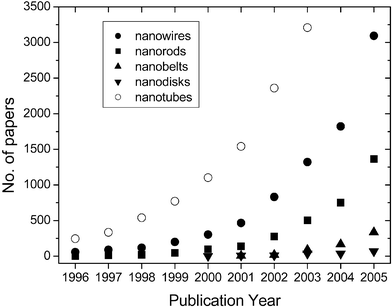 | ||
| Fig. 1 Time evolution of the number of papers published during the last decade, including certain keywords (as indicated) in their title. Source: ISI Web of Science®. | ||
This themed issue was conceived as a collection of selected contributions by some of the researchers who are most active and recognised as leaders in the field of anisotropic nanomaterials, but deliberately leaving carbon nanomaterials (carbon nanotubes in particular) aside, since they constitute a field on their own. While, obviously, not all of the leading groups could be represented here, the final collection of papers definitely provides an excellent overview of current research directions, and I would like to express my gratitude to all contributors for their effort and support toward this initiative. In what follows, a brief description of the papers included in this issue is provided, which intends to serve as an introduction to encourage further reading.
Three excellent feature articles cover extremely hot topics. Moore and Wang describe the formation of nanowires, nanorods, nanobelts and other fancy nanostructures made of ZnS, nicely showing that the final morphology is directly determined by the growth direction from the original seeds (Fig. 2). Yacaman and co-workers concentrate on the shape evolution of noble metals, describing the various morphologies that typically originate during the growth of small (twinned) metal nanoparticle seeds, including amazing examples from their high resolution electron microscopy (HRTEM) studies (Fig. 3). While these two feature articles are related to the growth processes leading to anisotropic nanomaterials, the one by Okamoto and Kimura deals with anisotropic metal nanomaterials characterization. In particular, they demonstrate the capability of directly imaging optical surface plasmon resonance modes within metal nanoparticles of various morphologies using a novel microscopy technique, namely scanning near field optical microscopy (SNOM). The unprecedented resolution achieved by HRTEM and SNOM using electrons and light, respectively, offer new possibilities for understanding the formation, the structure and the optical response of anisotropic nanomaterials.
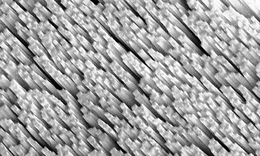 | ||
| Fig. 2 ZnS nanowire bundles from Moore and Wang. | ||
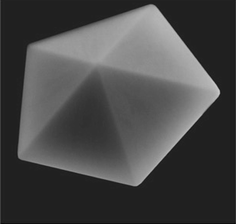 | ||
| Fig. 3 A decahedral nanoparticle from Yacaman et al. | ||
Three papers within this issue are specifically devoted to nanowires. Xia and team review in a highlight-type article their recent achievements on the use of various chemical transformation techniques to manipulate the composition and/or structure of nanowires (from a-Se into t-Se, subsequently into Ag2Se and ultimately into CdSe). Since these materials display different electronic properties, a number of novel applications arise which would have not been available otherwise, dramatically increasing the flexibility of the widely used polyol method. In a related study, Hunyadi and Murphy describe the formation of bimetallic Ag–Au nanowires and hollow gold nanotubes, again through chemical transformation (in this case galvanic replacement) of silver nanowires. The changes in chemical composition not only affect the surface plasmon response of the nanostructures, but also strongly determine their efficiency in surface-enhanced Raman scattering (SERS). On the other hand, Rao and co-workers report a detailed study on the efficiency of nanowires, in this case made of tungsten oxide, as hydrocarbon sensors, showing improvement when compared to more traditional V2O5 nanomaterials.
Four papers are concerned with nanorods, of which three describe the application of chemical processes for selective functionalization, based on the tailored deposition of a different material on nanorod templates. Liu and Guyot-Sionnest report a clever modification of their prior work on the growth of Ag shells on Au nanorods, showing that sulfide or selenide ions can convert the silver shells into Ag2S or Ag2Se, respectively, in an oxidizing environment (Fig. 4). Due to the high refractive index of the chalcogenides, the surface plasmon resonance is shifted toward lower energies, which agrees with simulations for ellipsoids. In contrast to this homogeneous coverage of Au rods, the contribution from Liz-Marzán's group demonstrates that growth of Pt on Au rods can be directed toward so-called tip-growth when residual Ag+ ions are present during Pt2+ reduction, again with notable optical effects related to plasmon modes. Anisotropy-directed reactions were also very nicely designed by Cozzoli, Manna and colleagues, on the basis of the deposition of Au on the tips of semiconductor (CdSe and CdS) nanorods, which were initially modified with PbSe (Fig. 5). All these papers clearly reveal the extremely high level of morphology control that can be achieved, mainly using colloid chemistry. In the fourth paper on nanorods, Hartland and co-workers present a detailed comparison of the mechanical properties of gold nanorods with different crystallographic structures, using a time-resolved spectroscopic technique which the same group recently devised to probe the Young's modulus of nanoparticles in solution.
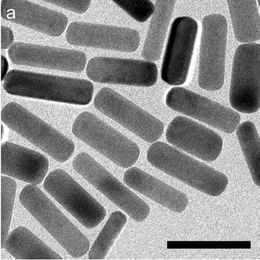 | ||
| Fig. 4 Gold nanorods from Guyot-Sionnest et al. | ||
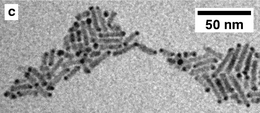 | ||
| Fig. 5 Gold tipped CdS nanorods from Manna, Cozzoli et al. | ||
Finally, two papers are included which deal with nanoplates. While Kotov and co-workers demonstrate the formation of highly monodisperse calcium phosphate platelets, with a structure closely resembling that of the corresponding natural material within bones, Niederberger et al. concentrate on the formation of supra-particle assemblies by tungsten oxide nanoplatelets stabilized with several organic (catechol) ligands, leading to a variety of ligand-dependent morphologies, in some cases including more than one hierarchical level. Such self-organization behaviour would definitely have not been accessible for isotropic nanoparticles and opens new avenues for the fabrication of functional materials with novel properties and opportunities to understand dipolar interactions as driving forces toward anisotropic assembly.
From this brief overview of the contents of this themed issue, one can readily realise that despite the relatively short time during which anisotropic nanomaterials have been studied, not only synthesis but also manipulation and characterisation have enormously advanced and even more sophisticated advancements can be expected in the near future, which will soon allow us to go one step farther and implement real devices based on these materials.
I strongly encourage the J. Mater. Chem. readers to pay attention to this selection of papers, in order to get a good insight about the state of the art in the field of anisotropic nanomaterials.
References
| This journal is © The Royal Society of Chemistry 2006 |
